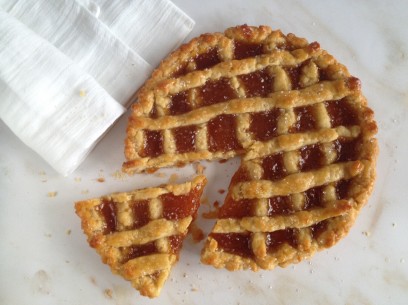 Pasta flora? No, The Greek Vegan hasn’t gone Italian – pasta flora is a delightful traditional jam tart and one of the most delicious, authentic sweet treats of Greece! A light, cookie-like crust with jam filling, this positively lovely dessert is found in Greek bakeries all over the world and can be on your table in less than an hour using ingredients in in your kitchen right now. Ready? Set? Go!!
Pasta flora? No, The Greek Vegan hasn’t gone Italian – pasta flora is a delightful traditional jam tart and one of the most delicious, authentic sweet treats of Greece! A light, cookie-like crust with jam filling, this positively lovely dessert is found in Greek bakeries all over the world and can be on your table in less than an hour using ingredients in in your kitchen right now. Ready? Set? Go!!
My go-to pan for pasta flora is a 9″ tart pan with fluted sides and removable bottom. It works really well here especially if you intend to remove the dessert from the pan to serve on a pretty plate as the sides will remain perfectly intact. Honestly, any pan at all with do though, round or rectangular. When it’s not going to be on display, make your pasta flora in any pan and then just cut and remove pieces out of it as you go. That’s the way we most often enjoyed it as kids 🙂
Oh and pasta flora can be made as individual tarts too which is always a fun presentation – I’ve used a whoopie pie pan successfully for this!
This recipe is ridiculously simple which you’d never guess when looking at the finished product! It’s more of a not-too-sweet cookie crust when it’s cooked, not like a pie crust. It holds up under the jam and the cookie texture/jam combination is amazing. Just combine dry ingredients, except sugar, in one bowl and wet ingredients including sugar and orange zest in another then mix together. Done. I recommend dissolving the sugar in the orange juice before whisking in the oil as things just seem to come together better when you go this route.
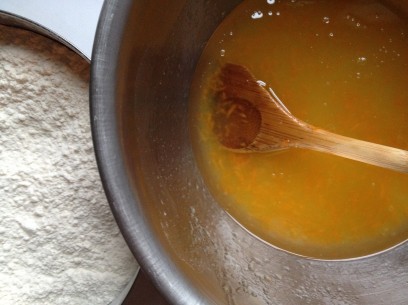
a very simple dough behind this very pretty dessert!
If you haven’t worked with oil doughs before, don’t be put off by their slightly greasiness. It may take a minute or two to get used to the different feel and then you won’t even notice. I find it helps, when I have the time, to refrigerate the dough in plastic wrap for 10-15 min at least. And the easiest way for me is to shape the dough into a log about 1 foot long, wrap in plastic wrap and then when ready to use, just mark off the log in thirds using 2/3 for the tart pan with 1/3 set aside for the dough snakes on top.
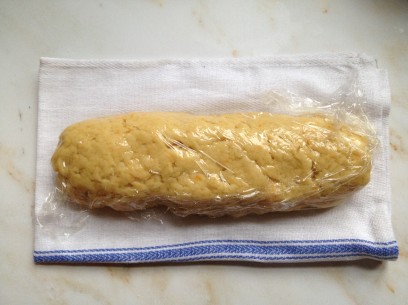
pasta flora dough log ready to refrigerate
Quick to assemble and real time saver, there’s no need to roll the dough – just place the 2/3 piece of dough directly into the tart pan and use your fingers or the flat back of a spoon to push the dough evenly across the bottom and up the sides of the pan. Traditionally, cooks add a few divots to the bottom crust as it’s said to hold the jam in better – definitely a fun part for any little bakers certainly 🙂
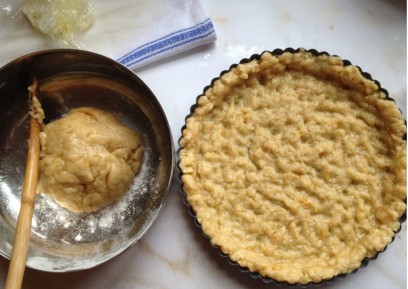
pasta flora dough in tart pan with divots
When rolling your dough snakes, work at a brisk pace and I recommend you use a bit of flour to roll with. For a 9″ tart, you’ll need at least 8 snakes – 4 on the bottom layer and 4 across the top. You can use as many as you like but for a nice lattice, at least 4 on top and 4 on bottom are needed. Once your bottom crust is down, spoon the jam onto the dough and spread out evenly to the edges.
Jam choice is completely up to you. The most well-known pasta flora filling to me is apricot jam with it’s gorgeous sunshiny orange glow and pictured above. For the tart below, I used a strawberry rhubarb jam – also fantastic! And when making for my aunt Helen, I use her favorite red raspberry so really go with whatever your tastes buds tell you 🙂

pasta flora traditional lattice pattern
Using the reserved 1/3 of your original dough log, just divide into 8 pieces. The dough is VERY forgiving so if your dough snakes break or aren’t quite long enough for the section you want, just pinch broken ends together or pinch on an extra piece.
Once rolled, gently lay dough snakes first over the jam and then the next layer cross wise over the first. If you don’t like the way your lattice pattern looks, carefully remove your dough snakes, wipe off any jam and roll out again or just rearrange. This is the most traditional lattice pattern but feel free to get creative and add slivered almonds to the jam squares in between the lattice!
Ingredients
- 1 cup sunflower oil
- 3/4 cup orange juice
- 2 tsp brandy or cognac
- jar of jam (between 12-15 ounces works well)
- 1/2 cup sugar
- 1 tsp vanilla powder
- 2 tsp orange zest (1 medium orange)
- 3 1/2 cups flour
- 1/4 tsp salt
- 1/4 tsp baking powder
- almond slivers (optional)
In a small bowl, mix apricot jam and brandy until combined and set aside.
Combine dry ingredients (except sugar) and set aside.
Whisk together orange juice and sugar. Add orange zest and sunflower oil. Whisk until well combined.
Add flour to liquids in 2 parts. Mix to completely combine and form into smooth ball of dough.
Roll dough into a log about 10-12 inches long. If you have time, wrap in plastic wrap and refrigerate for 10-15 minutes or up to 2 days. Remember to let it sit out at room temp for 30 minutes before using if you keep it refrigerated for more than 2 hours.
Mark off the dough log into thirds and cut off one third. Set the small piece aside.
Use the remaining two thirds piece of dough for the bottom of the tart pan. Press the dough along the bottom and up the sides of pan with your hands or even the back of a wooden spoon until you get an even layer all around.
With your fingers, press divots into the dough – holds the jam in 🙂
Spread apricot (or your choice of) jam in an even layer over the dough.
Divide small piece of dough into 8 pieces. Roll each piece and lay across the top of the jam in a lattice pattern (see picture above). If the dough snakes break, simply pinch the ends back together.
When laying the bottom layer of lattice dough rolls, fit the end of each snake inside of the dough side wall. The top layer of lattice should have the rolls go all the way from the edge of the tart pan, over the side and across to the other pan edge.
Bake in 375 degree oven for 35 minutes. Tart should be a soft golden brown and the edges just a bit darker brown.
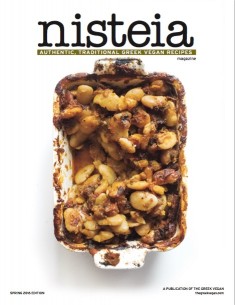
Order Nisteia Magazine Now!
56 full-color pages, 25 detailed recipes with gorgeous photos, 4 feature articles and perfect binding
Dedicated to celebrating the simplicity and beauty of authentic, traditional Greek vegan food.


So glad you did this post today! Just yesterday, my little girl declared Pasta Flora her favorite dessert, but I’ve never made it! Looking forward to giving this a try! : )
you’re raising a girl of good taste, Anna 🙂
it is gr8 but its so addictive
This looks both delicious and lovely!
Would a different type of oil work for this dough instead of sunflower oil? I only have olive and canola in my pantry at the moment.
Alya, Go with the canola – olive oil is a bit too strong a flavor for this dough to be honest. I suggest sunflower oil as it’s very light and an authentically Greek but any light vegetable oil will be fine. Let me know how you like it! Kiki 🙂
What do you say about substituting a good vanilla extract for the vanilla powder?
you can, Holly – vanilla powder is just a bit more subtle vanilla flavoring but certainly feel free to use vanilla extract when you need to. my substituting rule here – measure out extract in the amount of just ever so slightly more than half of however much powder is called for. either way, I know you’ll LOVE this tart, kiki 🙂
Hi Kiki – tried it and it has promise, considering… I will make it again for Christmas, now that I know the recipe. For me, the jam filling was too sweet. I will substitute a preserve with sugar content of 7g instead of 9g that I had used. Also, since I expected the standard presentation of recipe ingredients, I mistakenly omitted the oil, then had to dump it in at the end, when I realized it was up there as the first ingredient. Probably the dough will have better texture on my second try. I had missed it on the way to the jam filling which seems to intercept the wet and dry ingredients.. Perhaps, reprint with reorganized list of ingredients? Anyway, thanks for the recipe and Kala Xristougenna.
Kathryne, thanks for the feedback – I’m definitely going to update the ingredients list based on your experience. Makes sense, thanks for making me take a second look at the order! Kiki 🙂
Lovely!!!!! You learn something new every day. I had no idea the Greeks made this too. I am south american and this is very popular in Uruguay, Argentina. But we call it Pasta Frola.
🙂
https://en.wikipedia.org/wiki/Pastafrola
Our recipe is made with butter, well I now use vegan margarine.
We traditionally fill ours with quince paste, but dulce de leche (caramel) is my favourite. I have also made it with hazelnut paste. Hm, I’m going to make one this weekend.
I’m going to peruse the rest of your blog. It looks like our vegan group has a Greek cooking theme this week. I have no idea what to cook 🙂
Thanks for the inspiration.
Natalia, I think practically every country has a similar dessert to this one 🙂 It’s simple, very versatile – you can use a hundred different fillings!, and delicious! Good luck with your Greek vegan theme, you’ll find endless options on the internet – between this blog is a good collection of over a hundred delicious choices (and always growing) and google, you may have to have a Greek vegan themed month 🙂 Kiki xxxx
Just tried this yesterday for a family dinner and everyone loved it (kids & grown ups) – thanks! 🙂
I think I’ll start adopting this blog from now on… I happened to find it when I was travelling in Greece last week and looking for places where I can buy non-dairy sweets. Didn’t really help me during the trip – turns out almost everything there has milk or butter – but I knew I wanted to try some of the recipes here when I get back, so I did the day after I came back home 🙂
A couple of suggestions for this recipe: 1 – mention the size of the bowl needed each time (I used a small one for the sugar + juice since I didn’t realize that would be the one that would have to fit everything in it) and 2 – write the names of the ingredients meant to be combined each time (I thought the orange zest was part of the “dry” ones and only later understood it was meant to be with the sugar & oil).
Thanks again and I hope you keep those recipes coming!
Hello, I was looking for a vegan version of this pie because I want to make it in fasting days and lent. I just tried it and it was really fantastic !!! Thanks a lot. Easy, not-so-expensive, vegan, healthy and sooo tasty!! I made it with my homemade strawberry jam